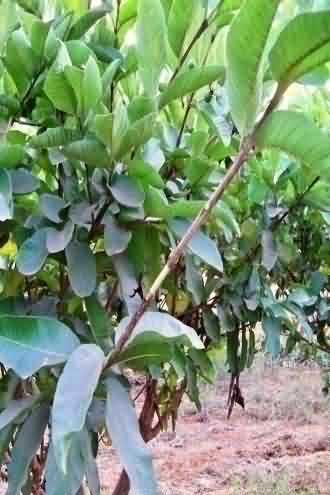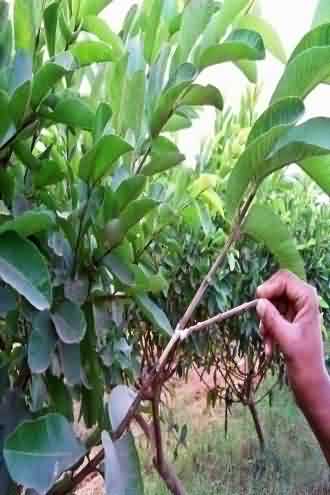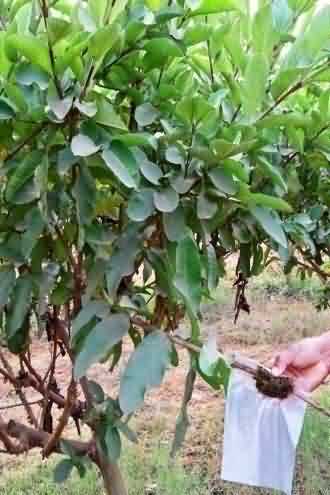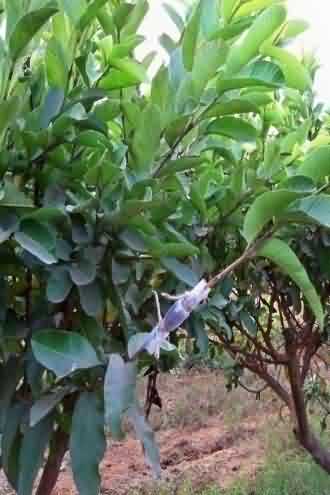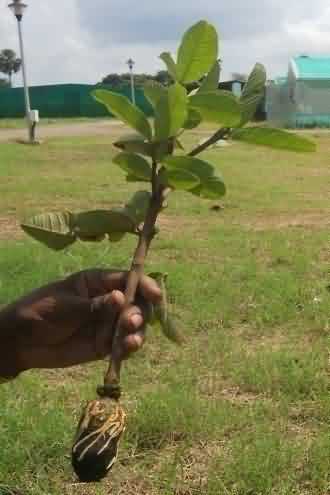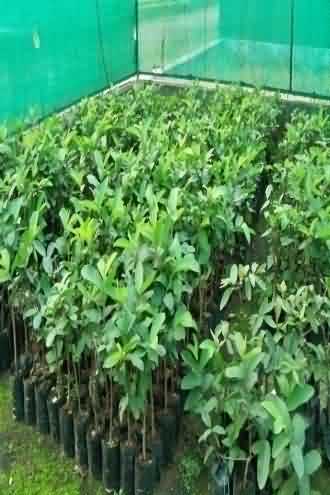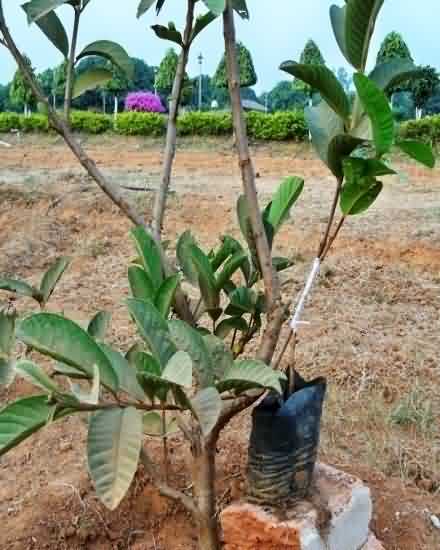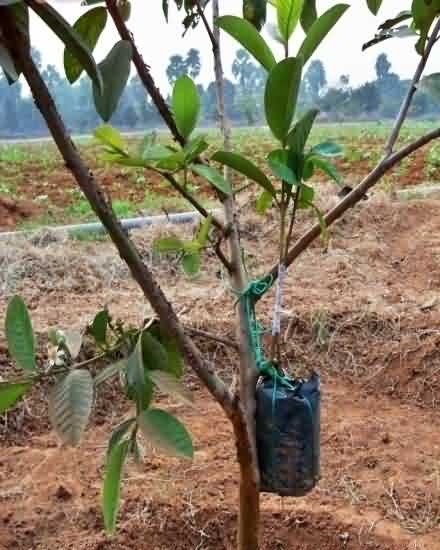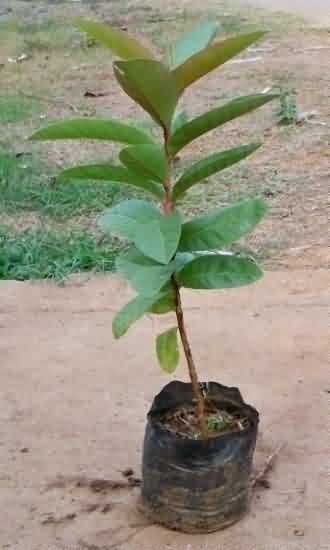अमरूद की वाणिज्यिक खेती के लिए वंशवृद्धी के तरीके।
Guava (Psidium guajava L.), an important fruit crop is grown throughout the tropical and sub-tropical parts of India due to its a hardy nature and wider adaptability. There has been a paradigm shift in its production system from subsistence to commercial cultivation.
Over the last decade (2001 -2010), the area and production have increased 1.3 times (1.55 to 2.05 lakh hectares) and 1.4 times (17.16 to 24.62 lakh tonnes), respectively.
In spite of substantial increase in area and production, there is an ample scope for area expansion; due to its precocious and prolific bearing habit, which in turn ensures high returns to the guava growers. True to the type planting material is the most vital component of area expansion.
Guava can be propagated by seeds as well as by vegetative means. However, vegetative propagation methods are preferred over the seed propagation because in spite of being self pollinated crop, cross pollination is common in guava.
Seed propagation cannot maintain the genetic purity and results in large variation in the seedling population because of segregation and recombination of characters during sexual reproduction. Variation in the plants affects the fruit quality, shape, size and yield.
Further seedling plants take 6-7 years to come into bearing stage. Seeds may be employed to raise rootstocks for grafting and budding.
I. Seedling raising for rootstock
Seedlings can be raised in the nursery beds or in polythene bags, however raising rootstocks in polyethylene bags is recommended due to better establishment of plants in the field on account of undisturbed tap root system. Moreover, rootstock raising in polyethylene bags is cost effective as it saves labour in weeding, watering, shifting and lifting of plants.
For raising seedlings extract fresh seeds from the fully matured ripe fruits and wash them thoroughly to remove the pulpy material clinging to the seeds. Guava seeds take long time to germinate because of a hard coating over the endocarp. Therefore, it is necessary to soak seeds in water for 12 hrs or in hydrochloric acid/ strong sulphuric acid for 3-5 minutes prior to sowing to facilitate their germination.
Seed viability declines very quickly after extraction from fruits therefore, seeds must be sown immediately after their extraction. Dip guava seeds in captan / thiram (0.2%) for 2 minutes before sowing for the management of damping off of seedlings. If the damping-off occurs after seedling emergence, both the seedlings and the media should be treated with copper oxychloride (0.3%).
Sow guava seeds in polyethylene bags (20x10 cm) filled with soil, sand and farmyard manures in 3:1:1 ratio. Soon after sowing of the seed, cover the polyethylene bags with 100 micron (400 gauge) white polyethylene sheet.
During winter months, the polyethylene mulch conserves heat and create conducive environment (microclimate) for rapid germination and early establishment of seedlings. Seed covered with polyethylene sheet gives as high as 95-97 per cent success within three weeks. These seedlings become ready in 8 to 12 months for budding or grafting.
II. Vegetative propagation for true to the type planting material
True to the type plants can be obtained through layering, grafting, stooling and budding. Guava is hard to root therefore; its propagation by cuttings under ordinary conditions is not successful. It is only successful under intermittent mist conditions with the aid of rooting hormones like IBA and NAA. Hence, propagation through cuttings is not generally followed in guava.
1. Air layering
Air layering is also known as ‘goottee’ which is mainly practiced during rainy season (June to September) because of high rooting and survival of layers (80-85%). For air layering 1 year old branches of 1 to 1.5 m length are selected.
A ring of bark of 2.5 to 3.0 cm long is removed from 45 cm away from the tip. For better rooting IBA (root promoting plant growth hormone) @ 4000-5000 ppm is applied at the upper cut end of girdled area. The girdled area is covered with moist sphagnum moss and wrapped with polythene tape. Rooting starts within 3-5 weeks.
After 6 to 8 weeks when sufficient roots are visible through the transparent tape, the layer is removed from the branch by means of cutting the stem below the girdled area in stages.
The polythene film is removed from the finally severed rooted stem and some of the top is headed back which is then potted and kept in the shade until new leaves appear. When the new flushes are produced, the plants can be transplanted in the field. Different steps followed in layering are shown in Fig.1.
| a.Removal of bark ring | b. Application of root promoting plant growth regulator | c. Covering of girdled area with moist moss | d. Layered branch |
| e. Detached air layered twig | f. Layered twig with developed roots | g. Potting of layer | h. Plants ready for planting |
Fig.1. Layering steps in guava.
2. Grafting in Guava
Grafting is practiced to take the advantage of well developed root system of the rootstock. In guava it can be done by two ways: inarching and wedge grafting.
a. Approach grafting/Inarching:
Inarching or approach grafting is the oldest technique employed in many guava growing areas. This methods yields very high success (85 to 95%) during rainy season.
In this method of propagation a thin slice of bark about 2.5-3 inches in length and about 1/3 inch in thickness at a height of 15-20 cm above the ground level is removed from the rootstock with sharp knife. A similar cut is made in the branch of mother plant to be used as scion.
The cut portions of both rootstock and scion are brought together and tied firmly with the help of grafting tape. After two months, stock above and scion below the union are cut gradually. Suckers sprouting from the rootstock are also removed. Inarching in guava is shown in Fig. 2.
| a.Removal of slice of Bark | b. Tied polythene potted rootstock with ground support of bricks | c. Polythene potted rootstock tied to the mother plant without any ground support |
Fig.2. Inarching in guava.
b. Wedge grafting:
The technique involves growing of seedlings in polyethylene bags, grafting, capping and hardening of grafts. Seedlings are raised for rootstocks in the nursery for approximately 6 to 8 months. When the stem diameter of seedling is of pencil thickness (0.5-1.0 cm) they are chosen for wedge grafting.
In this technique, proper selection and preparation of scion sticks is very important for obtaining higher success. 15-20 cm long shoots (3-4 months old) with 3-4 healthy buds and of pencil thickness should be selected for grafting.
Selected scion shoots are defoliated on the mother plant, about a week prior to detaching. At the same time, the apical growing portion of selected shoot is also beheaded. This helps in forcing the dormant buds to swell. In this way, the buds on the scion are ready to start sprouting at the time of grafting.
This treatment is essential for high success of grafts. After selection of the scion, rootstock (seedling) is headed back by retaining 15-20 cm long stem above the soil level in the polyethylene bag. The beheaded rootstock is split to about 4.0 - 4.5 cm deep through the centre of the stem with grafting knife.
A wedge shaped cut, slanting from both the sides (4.0 - 4.5 cm long) is made on the lower side of the scion shoot. The scion stick is then inserted into the split of the stock and pressed properly so that cambium tissues of rootstock and scion stick should come in contact with each other. Care must be exercised to match the cambium layer of the stock and scion along with full length of each component.
The union is then tied with the help of 150 gauge polyethylene strip, 2 cm in width and 25 - 30 cm in length. Immediately after grafting, the graft is covered by 2.5 x 18.0 cm long white polyethylene cap which is tied with rubber band at the lower end.
The scion starts sprouting after 10 to 12 days. The cap is removed after 25 days in the evening hours. The grafts are transferred to net house for hardening. Different steps followed in wedge grafting are shown in Fig.3.
| a. Rootstock | b. Heading back | c. Cut making | d. Grafting |
Fig.3. Wedge grafting in guava
III. Stooling in Guava
It is the easiest and cheapest method of guava propagation which has been standardized at Indian Agricultural Research Institute (IARI), New Delhi.
In this method plants are headed back to ground and shoots are allowed to develop on the beheaded stumps. When shoots attain a size of 20-25 cm, these are girdled at the base by removing a bark ring of 2- 2.5 cm.
Indole Butyric acid (IBA) @ 2,500 ppm in lanolin is applied to the upper portion of the girdled shoots and shoots are left open for 2-3 cm days after IBA application. These shoots are covered/ mounded with soil to encourage rooting in the stools.
After 6-8 weeks, the roots are fully developed in the shoots and these shoots can be separated and planted in nursery. The shoots are headed back to maintain the root and shoot balance before planting in the nursery.
Before separating the stools, a light irrigation should be given if soil is dry. After separating the shoots apply ample quantity of manures and fertilizers and level the field. Stooling can be done twice a year (spring and rainy season) and in this way, one can get 30-40 stools per mother plant per year.
The stooling of a mother stool can be done for many years.
IV. Budding in Guava
In areas of high atmospheric humidity budding could be practiced. Different budding techniques could be employed like forkert, shield and patch. Patch budding can be done during May –June with 75-80 per cent success.
For patch budding seedlings of pencil thickness and about one year age with uniform active growth are selected. The trees from which buds are taken should be highly vegetative with lush succulent growth to permit easy separation of buds from the stem.
It is better to take swollen and unsprouted dormant buds from leaf axils of mature twigs of the scion variety. A patch of approximately 1-1.5 cm length with a bud is removed from the scion variety. Similarly, 1-1.5 cm long patch is removed from the rootstock and bud is fitted into the remaining portion on the stock seedling.
Bud should be fitted at a height of nearly 15-20 cm above the ground level. Polyethylene strip is used for keeping the buds close to the stock. When the bark adheres tightly to the wood, budding is usually successful.
After about 2-3 weeks of budding the polyethylene strip can be opened to examine the success. In successful cases, about one-third shoot of the rootstock can be removed for forcing the growth of buds. The remaining two-thirds can be removed after three weeks of the first cutting, leaving about 2-3 cm above the bud.
In Odisha, air layering or goottee is the most common propagation method of guava due to better root emergence and survival rate (80-85%). Besides, it produces sufficiently large planting material which can be planted within 3-4 moths. Wedge grafting is also practiced up to some extent to take the advantage of well developed root system of rootstock.
Authors:
Deepa Samant, H.S. Singh, Kundan Kishore and P. Srinivas
Central Horticultural Experiment Station
(Regional research station of IIHR, Bangalore),
Aiginia, Bhubaneswar - 751019
Odisha, INDIA
email:

